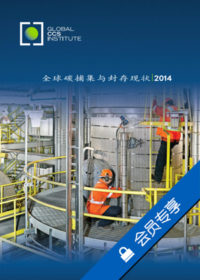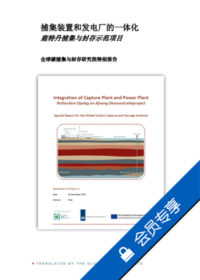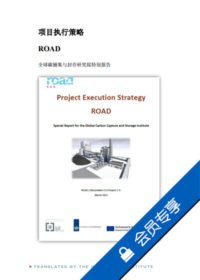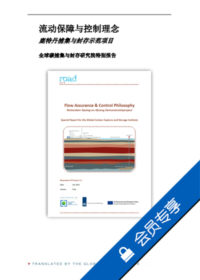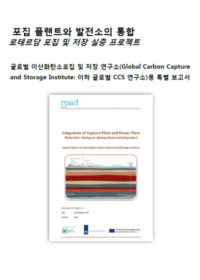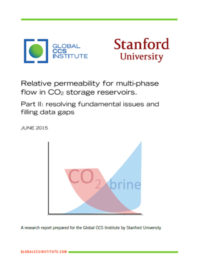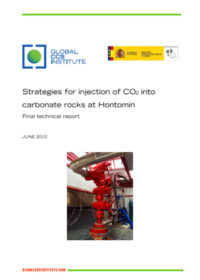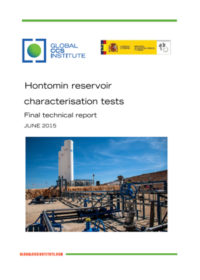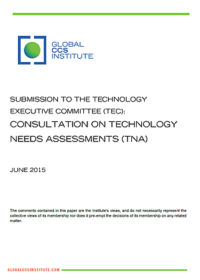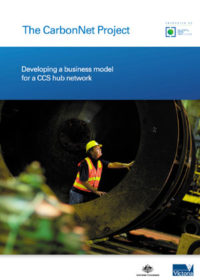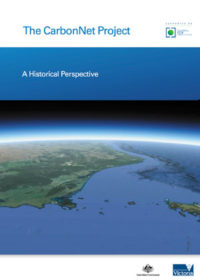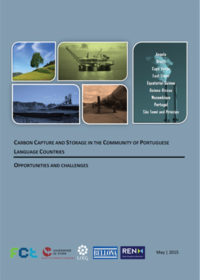Resources
Publications
Our publications, reports and research library hosts over 500 specialist reports and research papers on all topics associated with CCS.
View our Publication Library Disclaimer.
Filter by
全球碳捕集与封存研究院很高兴宣布2014年全球碳捕集与封存现状报告的发布。
本报告详述了世界范围内大型CCS项目的现状,认为:2014年对CCS来说是关键的一年,在这一年里CCS在电力行业成为了现实。
本报告介绍并提供了大约40个较小规模的“值得注意的”CCS项目的项目描述链接。2014年报告强调了日本“值得注意的”项目的数量。
2014年全球碳捕集与封存现状报告对全球和区域性的CCS发展以及支持缓解全球气候变化需要什么等进行了全面概述。为决策者们提供了一些主要的建议:2014年全球碳捕集与封存现状报告对企业、政府、研究实体和更广泛的社区都是一个重要的参考指南。
Disclaimer
The content within the Global CCS Institute Publications, Reports and Research Library is provided for information purposes only. We make every effort and take reasonable care to keep the content of this section up-to-date and error-free. However, we make no claim as to its accuracy, currency or reliability.
Content and material featured within this section of our website includes reports and research published by third parties. The content and material may include opinions and recommendations of third parties that do not reflect those held by the Global CCS Institute.
捕集装置和发电厂的一体化。鹿特丹捕集与封存示范项目。全球碳捕集与封存研究院特别报告
2nd July 2015
Topic(s): Carbon capture use and storage (CCUS), Engineering and project delivery
本报告关注马斯莱克迪电厂现有的燃煤1070兆瓦第三机组和ROAD项目拟建的新的250兆瓦规模的碳捕集厂的整合。碳捕集技术已经成为大量的降低碳捕集与封存成本研究的课题,也是很多刊物的主题。然而,与主要电厂的整合对于CCS链的效率和可操作性也有着重要的影响,是一项独立的非常大的项目成本。
Disclaimer
The content within the Global CCS Institute Publications, Reports and Research Library is provided for information purposes only. We make every effort and take reasonable care to keep the content of this section up-to-date and error-free. However, we make no claim as to its accuracy, currency or reliability.
Content and material featured within this section of our website includes reports and research published by third parties. The content and material may include opinions and recommendations of third parties that do not reflect those held by the Global CCS Institute.
项目执行策略。ROAD。全球碳捕集与封存研究院特别报告
2nd July 2015
Topic(s): Carbon capture use and storage (CCUS), Engineering and project delivery
随着总公司作出投资决策项目迈出了里程碑式的一步,本报告旨在对该项目的未来之路提出一个纲要。本报告还综述了即将到来的里程碑、相关活动的讨论以及项目执行战略。最终投资决策(FID)之后,将要组成两个连续组织,第一个关注于2015年之前的设计和建设,同时第二个将关注于2015年到2020年间项目的运行。该项目雇佣了来自两个总公司的技术专家,与战略伙伴一起在项目的开发和运行阶段发挥作用。
该项目进度由MPP3建设进度和成本优化所驱动。为了避免MPP3停机处罚,协调工作必须要走上正轨。ROAD关注于成本优化和控制。两个驱动因素都导致了具体建设计划和大型起重机组件的聚集。大型船只和主要压缩机的起重活动起着关键作用。由于大型起重机组件的聚集,成本和项目进度可以大幅压缩。这些主要组件的起重和布置之后,捕集厂就可以装配了。在第二个阶段,运输和封存工作将会是关注的重点。从前端设计阶段开始,更为详尽的设计让ROAD减少了不确定性。本报告讨论了施工、融资、调度、利益相关者参与和许可等执行阶段的风险。缓和风险的措施日渐地降低了项目意外开支。项目意外开支因不稳定的市场价格、工程细节状态、规划的不确定性和其他事件而显现出来。前端工程设计研究使得意外成本支出从总资本支出的25%(FEED前)减少到10%(FEED后)。施工阶段剩下的主要风险是与MPP3的联络、及时签署的捕集厂建设EPC合同、和意外支出风险与运输和封存链的商业磋商。此外,许可和利益相关者管理是注意的焦点。NGO或者地方组织对发放许可的反对或者上诉可能导致调度问题。
项目预算是由公司的组织结构控制,预算在项目办公司和管理、利益相关者管理、捕集、最后还有运输和封存中间分配。预算在整个项目周期中被分割成两个阶段:设计和施工阶段(2010-2014)和运行阶段(2015-2019)。进入运行阶段之后,已经制定出了厂退役和封存点监测的相关规定。考虑到风险的可能性和确定的减排措施,在ROAD的概率模型中,FID延期的调度风险也可能显现出来。请注意,本报告仅仅强调ROAD项目执行策略的主要方面。
Disclaimer
The content within the Global CCS Institute Publications, Reports and Research Library is provided for information purposes only. We make every effort and take reasonable care to keep the content of this section up-to-date and error-free. However, we make no claim as to its accuracy, currency or reliability.
Content and material featured within this section of our website includes reports and research published by third parties. The content and material may include opinions and recommendations of third parties that do not reflect those held by the Global CCS Institute.
流动保障与控制理念。鹿特丹捕集与封存示范项目。全球碳捕集与封存研究院特别报告
2nd July 2015
Topic(s): Carbon capture use and storage (CCUS), Engineering and project delivery
如荷兰的ROAD项目,大型CCS示范项目主要挑战之一是安全有效地控制一体化CCS链的二氧化碳流。对于ROAD项目来说,这意味着:从燃煤发电站的烟道气中捕集二氧化碳,压缩并通过一条长25km的管道运输到离岸平台,将其注入到海床下3.5km的废弃储层中。
这份有关ROAD项目的“流动保障和控制理念”的特别报告为在稳定状态、关机和启动状态中一体化CCS链的二氧化碳流的拟定的控制和运行系统提供了一些看法。
尽管之前已经付诸实践,ROAD项目进行的流动保障研究(FAS)清楚地表明了将(非常)低压的储层填充至300巴压强在实践中是可能的,但是必须要研究一下运输系统的物理配置参数的热动力所有方面下的二氧化碳行为。
Disclaimer
The content within the Global CCS Institute Publications, Reports and Research Library is provided for information purposes only. We make every effort and take reasonable care to keep the content of this section up-to-date and error-free. However, we make no claim as to its accuracy, currency or reliability.
Content and material featured within this section of our website includes reports and research published by third parties. The content and material may include opinions and recommendations of third parties that do not reflect those held by the Global CCS Institute.
포집 플랜트와 발전소의 통합. 로테르담 포집 및 저장 실증 프로젝트. 글로벌 이산화탄소포집 및 저장 연구소(Global Carbon Capture and Storage Institute: 이하 글로벌 CCS 연구소)용 특별 보고서
1st July 2015
Topic(s): Carbon capture use and storage (CCUS), CO2 capture
본 보고서는 마스플락터 발전소(MPP3)에 현재 존재하는 화력 1,070 MW 3기와 Rotterdam Opslag en Afvang Demonstratieproject(ROAD)의 새롭게 제안된 250 MW 등급 탄소 포집을 통합시키는 데 중점을 두고 있다. 탄소 포집 기술은 이산화탄소 포집 및 저장(CCS) 비용을 절감하기 위한 방대한 연구 주제와 다양한 간행물의 주제가 되어왔다. 그러나 주요 발전소와의 통합은 또한 CCS 체인의 효율성 및 조작성에 중요한 영향을 미치며 본질적으로 상당한 프로젝트 비용을 차지하게 된다
Korean translation of Integration of capture plant and power plant, Rotterdam Opslag en Afvang Demonstratieproject: special report for the Global Carbon Capture and Storage Institute
Disclaimer
The content within the Global CCS Institute Publications, Reports and Research Library is provided for information purposes only. We make every effort and take reasonable care to keep the content of this section up-to-date and error-free. However, we make no claim as to its accuracy, currency or reliability.
Content and material featured within this section of our website includes reports and research published by third parties. The content and material may include opinions and recommendations of third parties that do not reflect those held by the Global CCS Institute.
Relative permeability for multi-phase flow in CO2 storage reservoirs. Part II: resolving fundamental issues and filling data gaps
30th June 2015
Topic(s): Carbon capture use and storage (CCUS), CO2 storage
This report, prepared for the Global CCS Institute by a consortium of research organisations led by Stanford University, presents an assessment of fundamental issues pertaining to the relative permeability of brine and carbon dioxide (CO2) systems. This research follows an earlier report published by the Institute in August 2013 which provided an overview of this topic and highlighted knowledge gaps.
Relative permeability is an important factor in determining the fate and transport of CO2 over the lifetime of a storage project. To date only limited information on this critical factor has been available, much of which is summarised in the 2013 report. This report addresses key gaps in knowledge and data related to CO2 storage in saline formations.
Disclaimer
The content within the Global CCS Institute Publications, Reports and Research Library is provided for information purposes only. We make every effort and take reasonable care to keep the content of this section up-to-date and error-free. However, we make no claim as to its accuracy, currency or reliability.
Content and material featured within this section of our website includes reports and research published by third parties. The content and material may include opinions and recommendations of third parties that do not reflect those held by the Global CCS Institute.
Strategies for injection of CO2 into carbonate rocks at Hontomin: final technical report
29th June 2015
Topic(s): Carbon capture use and storage (CCUS), CO2 storage
This is a technical report examining the different strategies used for injection of CO2 into Carbonate Rocks at the Hontomin CO2 Storage Project in North West Spain. The report is authored by the CO2 injection team at CIUDEN (or Fundación Ciudad de la Energía – Spain's publicly funded energy research foundation), in collaboration with the Ground Water Hydrology Group of UPC-CSIC Barcelona.
The report aims to give an overview of current thinking around CO2, carbonate rocks and their interaction, before going into detailed description of the various CO2 injection strategies employed at the Hontomin test injection site.
A summary of the literature on CO2 thermodynamics, and a high level overview of the large volumes of literature on carbonate rocks and their interactions is provided, along with analysis of the performance and interpretation of simulation models and laboratory tests on the dynamics of CO2 injection and storage in carbonate rocks.
The report goes on to describe strategies for CO2 injection into carbonate formations, specifically focusing on:
- Push-pull tests
- Supercritical injection
- Liquid phase injection
- Pulsed (intermittent) injection
For each strategy, the shape and size of the CO2 plume and operational conditions for low permeability formations, are analysed. Mechanical stability issues are also discussed. It is hoped that the publication of these results from the Hontomin test injections, will contribute to the development of key site characterization techniques and the improvement of modelling approaches and field scale tests for evaluation of different CO2 injection strategies.
This report is published in connection with a further technical report from the CIUDEN team in Hontomin - Hontomin Reservoir characterization tests – and to a suite of bilingual community outreach and education initiatives created and delivered in the communities around the Hontomin site before, during and after construction of the injection site.
Disclaimer
The content within the Global CCS Institute Publications, Reports and Research Library is provided for information purposes only. We make every effort and take reasonable care to keep the content of this section up-to-date and error-free. However, we make no claim as to its accuracy, currency or reliability.
Content and material featured within this section of our website includes reports and research published by third parties. The content and material may include opinions and recommendations of third parties that do not reflect those held by the Global CCS Institute.
Hontomin Reservoir characterisation tests: final technical report
29th June 2015
Topic(s): Carbon capture use and storage (CCUS), CO2 storage
This is a technical report cataloguing the reservoir characterisation techniques emerging from the Hontomin CO2 Storage Project in North West Spain. The report is authored by the CO2 injection team at CIUDEN (or Fundación Ciudad de la Energía - Spain's publicly funded energy research foundation), in collaboration with the Ground Water Hydrology Group of UPC-CSIC Barcelona.
Building on existing research into CO2 injection into low permeability carbonates for enhanced oil recovery (CO2 -EOR) operations in North America, the Hontomin site provides an opportunity in Europe to develop injection and CO2 storage-related activities in a low permeability, carbonate deep saline aquifer. This novel approach for dedicated geological storage could provide learnings for potential storage operations in other sites of low permeability.
This report is published in connection with a further technical report from the CIUDEN team in Hontomin - Strategies for injection of CO2 into Carbonate Rocks at Hontomin – and to a suite of bilingual community outreach and education initiatives created and delivered in the communities around the Hontomin site before, during and after construction of the injection site.
Disclaimer
The content within the Global CCS Institute Publications, Reports and Research Library is provided for information purposes only. We make every effort and take reasonable care to keep the content of this section up-to-date and error-free. However, we make no claim as to its accuracy, currency or reliability.
Content and material featured within this section of our website includes reports and research published by third parties. The content and material may include opinions and recommendations of third parties that do not reflect those held by the Global CCS Institute.
Submission to the Technology Executive Committee (TEC): consultation on technology needs assessments (TNA)
29th June 2015
Topic(s): Carbon capture use and storage (CCUS), Policy law and regulation
The Institute's submission to the United Nations Framework Convention on Climate Change (UNFCCC) Secretariat, in response to the Technology Executive Committee's (TEC) taskforce on Technology Needs Assessments (TNAs).
Disclaimer
The content within the Global CCS Institute Publications, Reports and Research Library is provided for information purposes only. We make every effort and take reasonable care to keep the content of this section up-to-date and error-free. However, we make no claim as to its accuracy, currency or reliability.
Content and material featured within this section of our website includes reports and research published by third parties. The content and material may include opinions and recommendations of third parties that do not reflect those held by the Global CCS Institute.
The CarbonNet Project: developing a business model for a CCS hub network
25th June 2015
Topic(s): Carbon capture use and storage (CCUS), CO2 hubs
Victoria’s Department of Economic Development, Jobs, Transport and Resources prepared this Knowledge Sharing Report for the Global Carbon Capture and Storage Institute. This report defines a generic Carbon Capture and Storage (CCS) hub project, and outlines the commercial framework developed to support analysis of roles and responsibilities between the public and private sector in developing a CCS hub project.
Disclaimer
The content within the Global CCS Institute Publications, Reports and Research Library is provided for information purposes only. We make every effort and take reasonable care to keep the content of this section up-to-date and error-free. However, we make no claim as to its accuracy, currency or reliability.
Content and material featured within this section of our website includes reports and research published by third parties. The content and material may include opinions and recommendations of third parties that do not reflect those held by the Global CCS Institute.
The CarbonNet Project: a historical perspective
25th June 2015
Topic(s): Carbon capture use and storage (CCUS), CO2 hubs
Victoria’s Department of Economic Development, Jobs, Transport and Resources prepared this Knowledge Sharing Report for the Global Carbon Capture and Storage Institute. This report provides a historical perspective of CarbonNet from prior to its inception to now. It is intended to help project participants and their stakeholders understand how the vision of a network hub concept has developed in Victoria, Australia.
Disclaimer
The content within the Global CCS Institute Publications, Reports and Research Library is provided for information purposes only. We make every effort and take reasonable care to keep the content of this section up-to-date and error-free. However, we make no claim as to its accuracy, currency or reliability.
Content and material featured within this section of our website includes reports and research published by third parties. The content and material may include opinions and recommendations of third parties that do not reflect those held by the Global CCS Institute.
Carbon capture and storage in the community of Portuguese language countries: opportunities and challenges
18th June 2015
Topic(s): Carbon capture use and storage (CCUS)
This publication is an effort to bring CO2 Capture and Storage (CCS) onto the agenda of the community of Portuguese Language Countries (CPLP). It presents an overview of the industrial, energy and CO2 emissions profiles, and discusses the CO2 storage opportunities in each country.
This publication has been prepared by the partners of the project CCS‐PT: Perspectives for capture and sequestration of CO2 in Portugal. The Global CCS Institute supplied financial and technical contributions.
Disclaimer
The content within the Global CCS Institute Publications, Reports and Research Library is provided for information purposes only. We make every effort and take reasonable care to keep the content of this section up-to-date and error-free. However, we make no claim as to its accuracy, currency or reliability.
Content and material featured within this section of our website includes reports and research published by third parties. The content and material may include opinions and recommendations of third parties that do not reflect those held by the Global CCS Institute.
